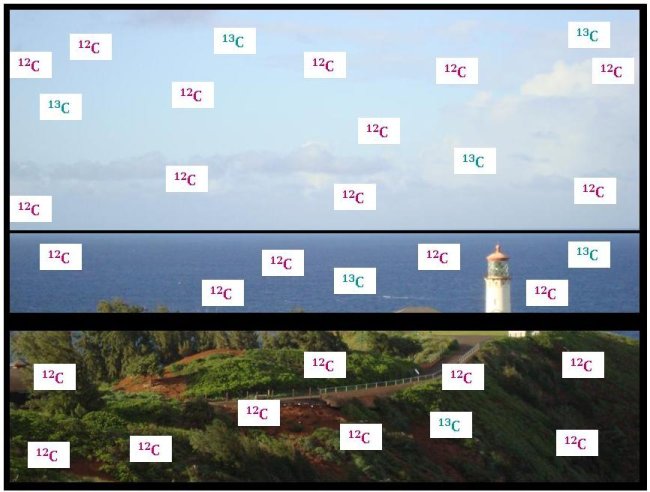The Basics: Stable Carbon and the Carbon Cycle
A Little Background…
Unlike 14C, the amount of 13C or 12C in an artifact does not change over time since both 13C and 12C are stable isotopes. In other words, they do not decay. Because they are stable isotopes, a 13C atom will always remain a 13C atom, and the same is true for 12C.
So Why are There Differences in Ratios of 13C and 12C?
Recall that there is much, much more 12C than 13C in the world –almost 99% of all carbon atoms are 12C. Even so, different carbon pools have different ratios of 13C and 12C – called isotopic fingerprints. The differences are small - one carbon pool may have 98.8% 12C while another may have 99.2% 12C - but modern machines, called isotope ratio mass spectrometers, can detect these differences quite easily. Pools with relatively more 13C (less 12C) are called “heavy” and those with less 13C are called “light”.
Let's look at the four main carbon pools with which climate scientists are concerned: the atmosphere, the terrestrial biosphere (land plants, animals, and soils), fossil fuels, and the ocean. The atmosphere has a certain ratio of 13C to 12C. This ratio is affected by the isotopic fingerprint of the source of new carbon dioxide to the atmosphere. Some sources of carbon dioxide are “heavy” while others are “light”. The ratio in the atmosphere is also affected by the isotopic fingerprint of carbon dioxide sinks. Do these sinks take in a lot of 13C or very little relative to the amount of 12C they take up from the atmosphere?
The Terrestrial Pool
The terrestrial biosphere has a very different ratio of 13C to 12C than the atmosphere. There are two main reasons; the first process is that 13C is heavier and moves less quickly. When plants photosynthesize carbon dioxide, they first capture air inside small openings in the leaves, called stomata, by a process called diffusion (diffusion is the random movement of particles from an area of higher concentration to an area with a lower concentration of that particular particle). As the air randomly enters the stomata, proportionally less heavy 13C enters a plant than the lighter and faster 12C (meaning that the isotopes fractionate according to their relative masses).
To portray this concept, imagine a pet store with a cage of baby mice. After a few days, the mice–whose eyes have not yet opened–start to wander around their cage. While the majority of the baby mice are skinny, some are fat. The fat mice weigh more and move around more slowly than the skinny mice–yet, like most baby animals, all of the mice are constantly moving.
The mice's cage has two rooms–the second one contains food for the mice. The smaller baby mice move faster, covering more area, and therefore have a higher chance of finding their way into the second room, where the food is. In comparison, the fat mice move more slowly. Thus, within the first few minutes, proportionally less of the fat mice make it into the second room–which is comparable to a plant's stomata, where proportionally less of the heavier 13C isotope enter through the small opening in the leaf.

The second, and actually more important, process occurs during photosynthesis (when plants use carbon dioxide for growth by “fixing” the carbon dioxide into simple sugars that can then be used for energy). In the terrestrial biosphere, atmospheric CO2 is converted into organic matter, such as sugars and wood). During photosynthesis, plants prefer to take in 12C over 13C. This, combined with the difference in diffusion, makes it so that plants have relatively less 13C when compared to 12C than the atmosphere 2.
To get a better idea, let's return to the mice and the pet store. Shoppers can only reach the mice in the second room of the cage. The majority of the shoppers prefer the skinny mice over the fat mice, so skinny mice are preferentially removed from the room, leaving behind a higher percentage of fat mice compared to the original proportion in the litter. Similar to plants with a preference for 12C over 13C during photosynthesis, the shoppers take home a higher percentage of skinny mice.
Fossil Fuels
Fossil fuels also have less 13C relative to 12C than the atmosphere. Why? It's simple–fossil fuels are ancient plants. The same principles behind the differences between the terrestrial biosphere and the atmosphere apply to fossil fuels. The only difference is that these ancient plants have been stored underground for millions of years–but this hasn't affected the stable isotopes in the fossil fuels.
And Finally to the Ocean
In contrast to the terrestrial biosphere and fossil fuels, the isotopic fingerprint of the ocean flux is very similar to the atmosphere. The ocean does not fractionate 12C from 13C nearly as much as the terrestrial biosphere, making the ocean flux's fingerprint similar to that of the atmosphere (in this case, the flux is the movement of carbon dioxide into and out of the ocean).
Back to the pet store–but now both rooms in the cage contain food. As before, the blind mice start to explore the cage. Although the fat mice still move more slowly, the mice do not prefer one room over another. After a long period of time all of the mice have evenly dispersed. Therefore, the ratio of skinny to fat mice is the same in the two rooms.


 Previous
Previous
